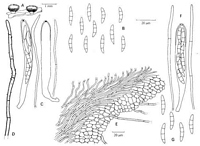|
 Lasiobelonium subflavidum Lasiobelonium subflavidum
SynonymsDasyscyphus triseptatus
BiostatusPresent in region - Indigenous. Non endemic
Images (click to enlarge)
Caption: FIG. 11. Dasyscyphus triseptatus. Habit sketch x 8, details x 660. | 
Caption: Figure 116. Lasiobelonium subflavidum. A-E. Dacyacyphus triseptatus, holotype. A.
Apothecia. B. Ascospores. C. Asci and paraphyses. D. Hair. E. Ectal excipulum on
receptacle. F-G. Beaton 185. F. Ascus and paraphyses. G. Asco |
Article: Spooner, B.M. (1987). Helotiales of Australasia: Geoglossaceae, Orbiliaceae, Sclerotiniaceae, Hyaloscyphaceae. Bibliotheca Mycologica 116: 711 p.
Description: APOTHECIA scattered or gregarious, often in swarms, superficial, subsessile. DISC 0.5-0.75
mm diam., concave, smooth, whitish or pale brown, margin inrolled when dry.
RECEPTACLE shallowly cupulate, often attenuated at the base, pale brown, clothed over at
least the upper part with long hairs. HAIRS slender, cylindrical, tapered to a rounded or
subacute apex, thin-walled, Multiseptate, brown to yellowish-brown, paler above and often
almost colourless at the apex, smooth or carrying amorphous granules mostly soluble in
Melzer's reagent, 150-400 (-500) µm long, shorter towards the base of the receptacle, 3-4 µm
diameter. ASCI (81)-85-100 (-106) x (8)-9-12 µm, 8-spored, cylindric-clavate, apex obtusely
conical, pore feebly blued by Melzer's reagent. ASCOSPORES 15-21(-25) x 3.0-3.8 µm,
mean 17.4(SD 1.6) x mean 3.2(SD 0.2) µm in the holotype of D. triseptatae), hyaline, fusoid,
often slightly curved, 3(-5)-septate, irregularly biseriate. PARAPHYSES narrowly lanceolate,
rarely acutely pointed, remotely septate, hyaline, 2-3 µm diam., equal to or only slightly
exceeding the asci. SUBHYMENIUM 15-20 µm thick, hyaline, composed of narrow
interwoven hyphae 2.0-2.5 µm diam. MEDULLARY EXCIPULUM composed of parallel,
hyaline, septate hyphae, 2-3 µm diam., in a layer 35-40 µm thick near the base of the
receptacle, narrowing towards the margin where it merges with the ectal layer. ECTAL
EXCIPULUM 45-50 µm thick at the base, narrowed towards the margin, formed of
subangular or rounded, isodiametric, hyaline or pale brown cells 8-12 µm diam.,
mostly thin-walled, arranged in rows at a high angle to the surface on the flanks of the receptacle.
Habitat: On dead wood and bark.
Distribution: Australia, New Zealand (Type
locality of D. triseptatus), North America (Type locality of L. subflavidum).
Notes: The synonymy of the species was established by Raitviir (1980). It is characterized
particularly by its mainly 3-septate fusoid ascospores which measure 15-22(-25) x 3.0-3.8 µm
in Australasian material. Korf (1978a) treated L. subflavidum as a synonym of L. boreale
(Ellis & Holw.) Raitviir but a slide of isotype material of the latter at K shows it to have
slightly longer, narrowly clavate or clavate-fusoid, nonseptate ascospores. (15)-21-25 x c. 3.5
µm and the taxa are clearly distinct, as Raitviir (1980) thought them to be. For more detailed
discussion of L. subflavidum and allied species see Raitviir (1980).
Article: Dennis, R.W.G. (1961). Some inoperculate Discomycetes from New Zealand. Kew Bulletin 15(2): 293-320.
Notes: Absence of a blue pore reaction with iodine may suggest a Perrotia but the paraphyses are
distinctly lanceolate and the tapering smooth-walled hairs bearing scattered, loosely attached,
rounded granules probably indicate rather a relationship with D. corticalis.
|